Tattoos of Indochina: Supernatural Mysteries of the Flesh
Article © 2010 Lars Krutak
From first-hand experience, I can honestly say that tattooing monks work very quickly. And in the blink of an eye another tiger, holy katha, seated Buddha or other magical tattoo comes into being on human flesh. Small tattoos are completed in ten to fifteen minutes, but more complex designs can take twice as long.
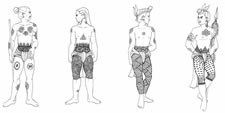 |
|
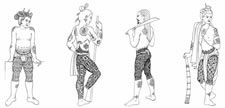 |
|
Drawings of Burmese men and their tattoo designs, 17th-18th centuries. The man on the far left shows the earliest known tattoo design called the Kaw Yit. |
|
Drawings of Burmese men with tattoo designs, armaments, and other adornments, 19th century. |
Payment schedules are not fixed, and it is usually up to the client to provide an "offering" to the monk and his temple for their services. These transactions may involve a small amount of cash (usually under one dollar) in addition to a lotus blossom, bundle of incense, and perhaps a couple of packs of regular or mentholated cigarettes. Such gifts are a means to “make merit” (Tham Boon in Thai), a Buddhist concept closely akin to (but not identified with) positive karma. Merit seems to grow over time, being augmented by karmically-positive actions (boon), but at the same time being decayed by sinful action (baap). Merit is often spoken of as the source of good luck, as a religious practice (e.g., praying), and as a kind of moral currency. Any compassionate or wise action is said to create merit, but one of the most powerful ways to make merit is by donating food, money, clothing or other objects to Buddhist monks. Another way to make merit, outside of becoming a monk, is to fund the construction of a temple, or failing that, to fund the repair or restoration of a temple.
Generally speaking, there are four classes of tattoos that can be received: those that act on others, causing them to like or fear the bearer; those that act on the bearer, increasing his skill with words causing the listener to do as he asks and instilling him with courage, or other tattoos that increase his agility; and tattoos that create a protective barrier around the person that prevent animals of all sorts from biting (especially poisonous snakes), knives from cutting, bullets from entering the body, and fire from burning the body. Magical tattoos, whether for these or other purposes (e.g., for eternal health), are in a sense like preventive medicine and can be thought of as kinds of vaccinations against various diseases and misfortunes.
 |
|
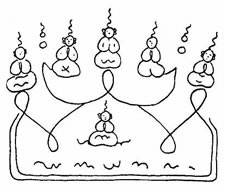 |
|
Magical Buddha tattoos from Laos, 1940. Designs A-B were worn to protect the owner from cuts and other wounds. Element C rendered the wearer invulnerable. |
|
Five Buddha tattoo, Laos, 1940. This complex design protected the wearer from bullets and bladed weapons and includes Sanskrit characters. The Buddhas portrayed are: Krakucchanda, Kanakamuni, Kacyapa, Gautama, and Maitreya. |
But there are other tattoos that you cannot see because they are invisible. These are oil tattoos which are said to be just as powerful as the pigmented variety. Some monks use sesame or coconut oil which is then mixed with other herbs and sandalwood. Many of the most powerful arjans are covered in these types of tattoos, while others wear a combination of both varieties.
The belief in the potency of these and other forms of magical tattoos is certainly as ineradicable as the indelible designs themselves. But one account of 1881 sheds some negative light on the potency of one particular kind of tattoo. More specifically, a young Burmese man desired the figure of the great peguan byeing bird or egret tattooed upon him to preserve him from drowning. Once the design was completed, the young man suggested that an experiment be conducted to confirm the power of the tattoo.
Accordingly his hands and feet were tied, and he was tossed over the side of a boat into the Rangoon River. The under-currents in the river were very dangerous, and the poor fellow was never seen again. The tattooers, master and assistant, were brought up on a charge of murder [by the British] and convicted of manslaughter, but the great mass of the Burman population thought they were very badly treated and that they were not charlatans because perhaps they made an astrological miscalculation before administering the tattoo.
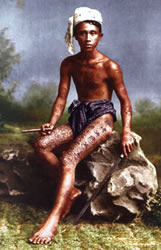 |
|
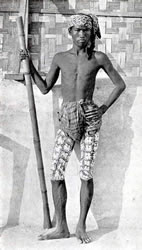 |
|
Young Burmese men with tattooed “pantaloons,” ca. 1900. One-hundred years ago, opium was given to young men in Burma to ease the pain of their tattoos, especially when placed on the tender inner thigh area and kneecaps. Designs were varied and included legendary characters (the cannibal king Bawdithada), mythical beasts and monsters, tigers (singha), dragons (nagas), the Hindu monkey king Hanuman, birds and other popular animals. Men selected these and other creatures in the belief that their natural instincts could be transferred through the tattoo image into the human body. Soldiers and thieves (dacoits) preferred tigers and other cats because they believed that they would gain their strength, stealth, and agility. Hanuman was thought to embody longevity, while men seeking protection from bullets, sword cuts, and beatings had the image of Bawdithada inked upon their skins.
Layman tattooists in Mandalay often chanted religious tales while executing the trouser-like tattoos of their Burmese clients to imbue them with power. The following tale (ca. 1900), which was to be repeated seven times during the tattoo session, was supposed to make the client’s indelible love charmmore effective:
I was a Koothah Min, I. At the time when Papawadee was my queen, when I routed the kings of all seven countries who came suing for her hand. Right beautiful was she, fair as the malla flower when it perfumes the forest with its odours. I the great Koothah Yaza!” (Kootha Yaza was the hero of one of the 510 Zahts or Jataka tales detailing the previous births of the Lord Buddha.)
|
Another kind of Burmese tattooing that only highly powerful sayas specialized in was that of ah kyan say, or the “violent medicine”, which had the power to turn an ordinary person into a Bawdithada, or superman – invincible, destructive and immensely powerful. However, if the ritual that accompanied the tattooing was not properly carried out, the tattoos had the power to unhinge the mind of the client and he would go mad instead. For example, the “deranged” would frequent graveyards, tearing up and trying to devour corpses like a ghoul.
The tradition of ah kyan say has its origins with the cannibal King Porisada of India, or Bawdithada as the Burmese call him. His irresistible thirst for flesh, first beef then human, ultimately led to the loss of his kingdom and subsequent banishment to the jungle where he became a tremendous athlete and was able to “run like a lion” among other incredible feats. Eventually he was “saved” by the incarnate Buddha himself and that is why ah kyan say tattoo is believed to hold so much power if it can be managed by the individual who wears it. Some writers suggest that there are three designs which are associated with him, each depicting an episode in his life. Whereas others state that still more tattoos actually embody the power of Bawdithada. An account of the late 19th century describes ay kyan say in more detail:
One of the most weird and extraordinary superstitions among the Burmans is connected with tattooing, and is called “Bandee-tha” [Bawdithada]. When some credulous Burman wished to become a great warrior, or, more probably, a great thief and robber, he applies to one of these ‘doctors’ [sayas], who directs him to procure a piece of flesh about six inches long from a human corpse. The flesh of a man who has been hung, or died on a Saturday is most eagerly sought. Also certain parts of the body, the nose, fingers, and ears especially, having been dried and carefully compounded with various magical drugs, the [tattoo] mixture is then preserved. After sundry ceremonies, the figure of a cat or a demon or ‘beloo’ [belu] was tattooed on the patient’s breast with the medicine [pigment] prepared, he all the while biting and chewing the piece of raw human flesh. The supposed effect of this wonderful and disgusting operation is to enable the man to leap like a cat prodigious heights and lengths – a hundred feet would be nothing; or else to endow him with the strength, ferocity, and power of a demon. An instance has been known, where the relatives of a criminal who had been hung sold his body to these ‘doctors,’ as they are called, after it has been handed over to them for burial by the authorities. The writer once had a case in which, after, in the performance of his duty, having superintended the execution of a murderer, finding no relatives come forward to claim the body, causing it to be decently interred; but, in consequence of information received, on opening the grave a couple of days afterwards, the body was found mutilated as above described (Forbes 1878).
J.G. Scott (1896) added additional details, including the “maddening” effects of such a tattoo on a young Burmese boy he knew. This tattoo was administered by a wandering tattoo master who was not necessarily a monk, although he may have been a disrobed priest, but rather a kind of “doctor” (described by Forbes above) that was likewise called a saya in the Buddhist tradition. These men were skilled in both traditional herbal medicine and medicine that channeled the power of the Buddha. Sometimes they tutored one or more apprentices and always carried a parabaik or folding book of designs. After the saya had painted the desired stencil, he would stretch the skin of the client by placing his feet a few inches from the design and then lean inward between his parted knees to execute the tattoo. Sometimes the client’s thighs swelled so badly that he was incapable of walking properly for a week or more. And it is incredible to learn that the fatality rate from infection was largely negligible. Perhaps this speaks to the magical power that was believed to embody and emanate from the saya himself. As Scott noted over one hundred years ago:
There are but very few sayahs who are acquainted with the necessary drugs and incantations, and fewer people still who have the courage to submit to the operation, for many men are pointed out whose mind has given way under the gruesome process, and who wander about graveyards, gnashing their teeth and fumbling about for human bones to gnaw and mouth. And no wonder, for some tattooers make them chew the raw flesh of a man who has been hanged, while the figure is being tattooed on the breast[!]
Some become Baw-dee-thah-da without knowing it, and without the sickening necessity of mumbling human flesh like a ghoul. I knew an instance in a monastery. The patient was a boarder about fourteen years of age. A Shan tattooer wandering about the country spent a couple of nights there, and the boy, attracted by the fellow’s eerie tales, managed to save up a good many tidbits for him from the food going in the monastery. Out of gratitude, and having nothing better to give him, for he was very poor and homeless, the sayah tattooed on the lad a figure with singular drugs, muttering queer phrases the while. Then he went away saying no more than that it would make the boy very strong.
In about a month’s time the boy displayed unmistakable signs of being a Baw-dee-thah-da. He leapt enormous heights in the air, jumped about and ran at random, carried with the utmost ease things which no one else could move. The abbot locked him up in a sadeik, the box in which the palm-leaf manuscripts were kept; he got out without injuring the lock in any way, sprang on to the roof of the monastery, forty feet in height, and turned a somersault to the ground without hurting himself in the least. He has been a boy of very soft, easy temper, and now he became fiery and uncertain, and with his vast strength, very dangerous. He only calmed down when a monk preached the law to him. He was constantly doing marvelous things; one day he walked across the river in front of the monastery, holding a monk’s ohk, or food canister, in his hands. The depth of the water was over six fathoms, but it did not reach higher than his waist. On another occasion a tree which was being cut down fell on him. He sank into the ground and came forth quite uninjured... After some years he became a dacoit [brigand], but a holy ascetic came across him, soothed him with the payeht gyee [Pali sermons and forms of worship], and then with a rusty nail and sacred medicines, tattooed out the figure put on with such lamentable results by the Shan sayah…He was fortunate; most Baw-dee-thah-das have to be killed in their sleep.
Aside from such magical tattoos, other charms were used by men in Indochina for protective purposes. Sometimes these objects included rubies, balls of mercury, silver, gold, or lead discs, pieces of tortoise shell, and bits of horn that were blessed by a priest and implanted into the skin. Most of these consecrated objects also contained incantations written upon them or mystical animals to enhance their supernatural effect. Engraved fish, monkeys, crabs or peacocks appearing on these talismans related to the various forms the Buddha assumed in his previous lives before taking his human form. These animals were believed to be imbued with intelligence and wisdom and wearing them endowed the person with their attributes. Two 19th century writers focusing on Burma (today Myanmar) described these implantation devices as follows:
It is not at all uncommon to meet a Shan with several knobs on his chest, concealing the talismans that he has inserted as charms to render him proof against bullet and sword…
Many famed dacoits [thieves] have long rows and curves of them over the chest, showing in little knobs through the skin. When they get into English prisons, an energetic jailer has been known to cut them out, lest they should be pieces of gold or silver, or perhaps precious stones, with which turnkeys might be bribed. The usual result is to break the robber’s spirit. Once the continuity is interrupted the consecration is gone.
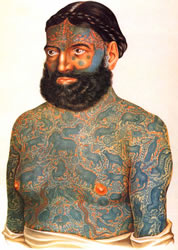 |
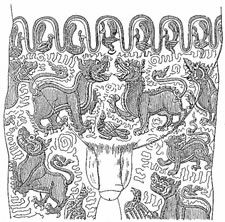 |
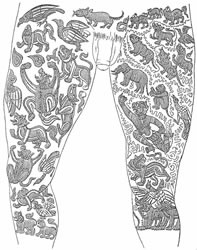 |
| The famous 19th century circus attraction Prince Constantine who bore 388 Burmese tattoos. |
Magical trouser tattoos from Laos, 19th century. |
Magical trouser tattoos from Laos, 19th century. |
Next Page | 1
|
2 |
3 |
4 |
Museum photo gallery of the images
on this page may
be seen here. |









